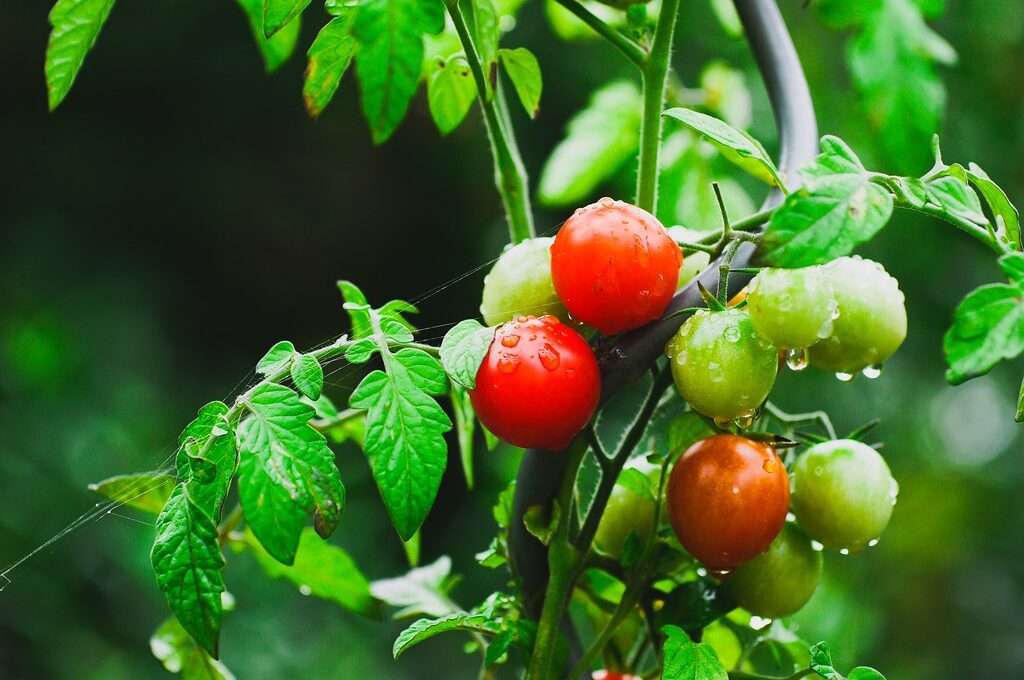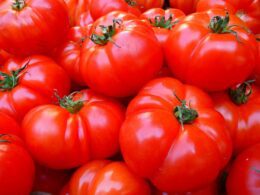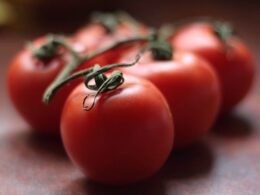Taking care of your tomato plants in pots is a great way to enjoy the delicious fruit that comes with growing your own tomatoes. But it’s important to make sure you’re watering them correctly – at the right time of day.
So when should you be watering your tomatoes in pots? This article will explore the benefits and drawbacks of watering tomatoes in the morning or other times of day, as well as considerations for watering tomatoes in pots and tips for doing so successfully.
Get ready to give your tomato plants the best start possible!
Benefits of Watering Tomatoes in the Morning
By watering your tomatoes in the morning, you can take advantage of the numerous benefits this time of day provides. The soil quality will be more consistent thanks to cooler temperatures that occur during sunrise. This helps retain moisture in the soil and prevent nutrients from evaporating too quickly. Plus, you get to enjoy a bit of sunshine as you take care of your garden!
Not only is it easier for the water to absorb into the ground when it’s cooler outside, but also because there is less temperature variance between night and day, allowing for better nutrient absorption. Furthermore, because the sun hasn’t yet reached its peak intensity during this time of day, your plants won’t be exposed to extreme heat levels that can damage them or cause them to become dehydrated too quickly.
The positive effects of watering tomatoes in the morning are hard to ignore. You’ll be able to maintain a healthier environment for your plants by providing them with consistent soil quality and optimal temperatures throughout their growing season. So why wait? Get out there and start giving your tomatoes some much-needed TLC!
Drawbacks of Watering Tomatoes in the Morning
As the sun rises, it lures moisture from the soil in your potted tomatoes, leaving them vulnerable and thirsty. Watering your tomatoes in the morning can have some drawbacks; namely, it can cause a decrease in water temperature and increased soil moisture.
The decrease in water temperature may be problematic for young tomato plants as they’re sensitive to cold temperatures. When watering in the morning, there’s a risk that cold water will shock their delicate root systems.
Additionally, too much soil moisture can lead to fungal diseases or root rot, which could ultimately kill your tomato plant.
Finally, not allowing enough time for evaporation before nightfall can expose your tomato plant to excessive humidity, which could cause disease development on the leaves and stems overnight.
It’s best to take into account these risks when deciding when to water your tomatoes:
- Monitor temperature fluctuations throughout the day so you don’t expose tomatoes to cold water shocks
- Check soil moisture levels often so you don’t overwater and create an environment conducive for fungal disease growth
- Allow adequate time for evaporation before nightfall so humidity doesn’t become excessive during cooler hours.
Benefits of Watering Tomatoes at Other Times of the Day
Watering your tomato plants at different times of the day can bring some benefits, so don’t just stick to the morning! Here are five advantages of watering your tomatoes during other times of the day.
| Advantage | Time |
|---|---|
| Cooler Temperatures | Nearly Evening |
| Less Water Evaporation | Late Afternoon |
| More Time for Plants to Absorb Water and Nutrients | Late Afternoon |
| Opportunity for Weeding and Pruning Before Sunlight Hits Plant Leaves | Nearly Evening or Late Afternoon |
| Fewer Fungal Infections on Leaves Due to Lower Humidity Levels During Nighttime Hours | Nearly Evening or Late Afternoon |
Cooler temperatures in the nearly evening hours increase the amount of water that your tomatoes can absorb. In addition, late afternoon sun will have already evaporated much of the available moisture, making it easier for plants to take up water without wasting any. At this time, they also have a better opportunity to absorb essential nutrients from fertilizer and compost. If you choose late afternoon as your watering window, you’ll also get an extra chance at weeding and pruning before sunlight hits plant leaves – something that should be done regularly but is especially important when dealing with tomato plants in pots. Finally, nighttime humidity levels tend to be lower than daytime levels which helps prevent fungal infections on leaves due to excessive moisture accumulation during hotter parts of the day.
Taking these factors into account, it’s clear that there are many advantages to watering your tomatoes at different times during the day rather than sticking exclusively with mornings. While some gardeners may prefer their morning routine, there is no denying that varying when you water can help ensure healthier plants overall!
Drawbacks of Watering Tomatoes at Other Times of the Day
Although there are some benefits to watering your tomato plants at different times of the day, it’s important to be aware of potential drawbacks as well.
Late night watering can be a bad idea if temperatures drop too low, since tomatoes need warmth in order to thrive. Also, if you water late at night and the soil is still wet when morning arrives, this could lead to fungal diseases that could damage or destroy your tomatoes.
The same goes for afternoon showers; while they may help keep the temperature down on hot days, they can also make the leaves more susceptible to disease due to an increased level of humidity in the air. In addition, if you’re using an overhead sprinkler system for your tomatoes, it can cause water droplets that will cling to the leaves overnight and provide a perfect environment for fungi growth.
Therefore, when deciding what time of day is best for watering your tomatoes in pots, consider factors such as temperature and humidity levels along with any potential risks associated with each time frame. Ultimately, finding the balance between giving them enough water but not too much is key for keeping them healthy and happy!
Should I Stop Feeding My Tomatoes Before or After Watering Them?
Knowing when to stop feeding tomatoes can significantly impact their growth. It is generally recommended to cease feeding them around two weeks before the anticipated harvest, allowing their flavors to develop fully. However, it is crucial to continue watering them regularly until the end to avoid dehydration and ensure a bountiful harvest.
Considerations for Watering Tomatoes in Pots
When deciding how to best nourish your tomato plants in pots, it’s important to consider factors such as temperature, humidity, and potential risks associated with each watering option. Proper soil preparation is essential for tomato success in containers. Soil should contain a combination of organic matter such as compost or peat moss along with coarse sand or perlite, which will help retain moisture and improve drainage.
The correct watering technique is also crucial when caring for tomatoes in pots – they need consistent moisture but should not be overwatered. To prevent waterlogging, always water the soil at the base of the plant rather than over the leaves, and make sure there are plenty of drainage holes in the bottom of your pot.
Temperature can also affect how much and how often you should water your tomatoes. In summertime, you may need to water more frequently due to higher temperatures and increased evaporation; conversely, cooler temperatures will require less frequent watering. You’ll also want to monitor levels of humidity around your plants – if it’s consistently low then you may need to increase your watering frequency accordingly.
Finally, bear in mind that too little or too much water can both cause problems; too little can lead to wilting while overwatering can cause root rot or other diseases due to poor aeration of the soil. It’s best practice to check the soil daily by sticking your finger down into it before deciding whether or not to water – this way you’ll know exactly how moist (or dry) it is and be able to adjust accordingly.
With careful monitoring and effective watering techniques, you’ll be rewarded with healthy tomato plants throughout the season!
Tips for Watering Tomatoes in Pots
Getting the watering right for your potted tomatoes is key to their success, so be sure to check the soil daily and adjust your routine accordingly. Here are some helpful tips that will help you make sure your tomatoes get just the right amount of water:
-
Watering Frequency:
-
Water your tomato plants as soon as the top 1-2 inches of soil feel dry.
-
If possible, try to water in the morning or late afternoon as this will reduce evaporation and give plant roots time to absorb moisture before nightfall.
-
Avoid overwatering by checking the soil first with a finger test; if it’s still damp, wait another day before watering again.
-
Pot Size:
-
The size of pot you use can have an impact on how often you need to water your tomatoes. Smaller pots require more frequent watering since they tend to dry out faster than larger ones.
-
Additionally, using a potting mix specifically designed for container gardening will help retain moisture longer than regular garden soil.
Knowing when and how much to water is critical for healthy tomato plants in pots – invest some time into learning about these factors so that you can create an effective watering regime that suits your needs!
Frequently Asked Questions
What type of soil do I need to use for tomato plants in pots?
You need soil with good quality for your tomato plants in pots to thrive. Look for a potting mix that has good water drainage, as tomatoes don’t like to have their roots sitting in wet soil.
Look for organic ingredients, such as compost and peat moss, which will provide nutrients to promote healthy plant growth. Avoid using garden soil from your yard—it’s too heavy and can cause waterlogged conditions which can lead to root rot.
With the right soil, you’ll be able to give your tomatoes all they need to grow big and strong!
How often do I need to water tomato plants in pots?
Watering tomato plants in pots requires you to adjust the frequency depending on their location and light exposure.
If your pots are placed outdoors, water them when the top inch of soil is dry. In hot summer days, you may need to water twice a day.
For indoor plants, check the soil every couple of days and if it’s dry about an inch deep, water your tomatoes until you see some drainage coming out from the bottom of the pot.
How much water should I give my tomato plants in pots?
When watering tomato plants in pots, it’s important to choose containers with adequate drainage holes and to prevent wilting by giving the plants enough water. To do this, you should provide your tomato plants with about 1-2 inches of water per week.
If temperatures are high and there is no rain, you may need to increase the amount of water slightly. When applying water, make sure to moisten the soil evenly throughout the pot.
Can I add fertilizer to the water for tomato plants in pots?
Yes, you can add fertilizer to the water when watering your tomato plants in pots. However, it’s important to consider the optimal timing and balance of nutrients for the best results. Adding too much fertilizer at once can burn the roots of your plant and stunt growth.
It’s best to apply a diluted solution of fertilizer every two weeks during the growing season for optimal absorption by your tomato plants.
What are the signs of over-watering tomato plants in pots?
If you’re growing tomatoes in pots, it’s important to watch out for signs of over-watering. Symptoms of overwatering can include yellow leaves, wilting foliage, and leaf drop.
Disease prevention is also important when watering tomatoes in pots; use only clean water with good quality that’s been tested or filtered.
Over-watering can lead to serious problems like root rot, which can quickly kill a tomato plant if not addressed promptly.
Be sure to keep an eye on your plants and adjust your watering schedule as needed.
Conclusion
You should water your tomatoes in pots at least once a day, ideally in the morning. This will help to ensure that the soil stays moist, which is important for healthy tomato growth.
However, if you can’t water in the morning then you can do so at other times of the day. Just make sure that you avoid excessively wetting the leaves as this can cause disease.
Be aware of temperature and humidity levels when watering and make sure you adjust accordingly to avoid any potential problems. All things considered, proper watering is essential for growing healthy tomatoes in pots!









